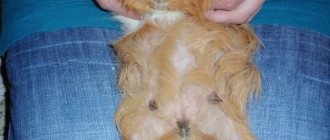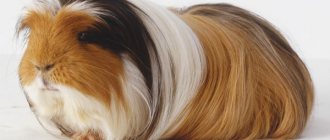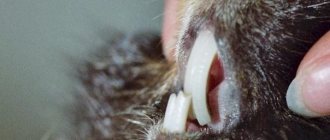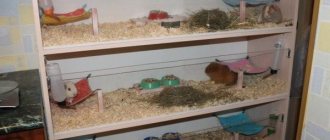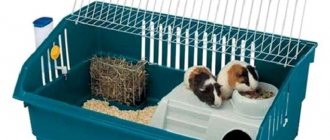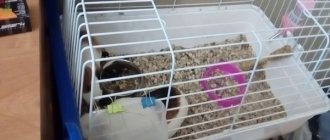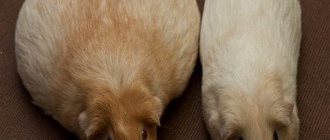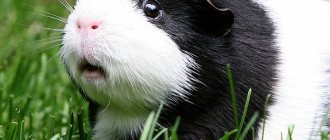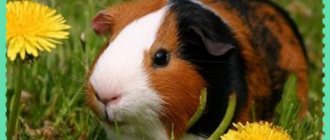Walking a guinea pig on a leash is not a Japanese exoticism, but a real picture that can be seen more and more often. A leash for a guinea pig is a simultaneous solution to 3 problems:
- The rodent grazes on fresh grass, allowing it to rummage in the ground and run around outside the cage. Fresh grass, sun and freedom are pleasures that will make your pet even happier.
- Eliminating the risk of escaping. Without a leash, a pig can scurry into the bushes and hide there. This happens when cats and dogs appear nearby.
- Reducing the risk of obesity. After the winter season of feeding cereals, pets gain weight. Walking around the yard or even around a large room will help burn off excess calories.
Types of leashes
Pet stores offer a large selection:
This type of collar specifically for hamsters is rarely used, only if the pet is a large breed. Usually it is worn as a decoration, since walking with such a collar is problematic, because the pet can slip out of it at any moment.
This type of collar is more reliable and is best suited for walking. A loop made of leather or fabric material secures the body and legs and is attached to the back. This design will definitely not allow the animal to wriggle out. The harness is put on loosely, so that you can stick your finger into the gap between the loop and the hamster’s body. The collar should not be worn tightly or loosely, otherwise the hamster can be injured or create conditions for escape.
A vest harness is much safer and more reliable. It is believed that the hamster is more comfortable in it
Please note that the harness and collar must be securely fastened, otherwise the hamster may be lost somewhere
Another worthy option for walking your pet. The walking ball is not a leash, but at the same time it is quite comfortable to use. The material of the device is usually plastic, the ball is dotted with special holes. This option is best suited for walking dzhungarikas or other small breeds, so the hamster will definitely not run away. Larger breeds of rodents will feel uncomfortable, so their use does not make sense.
DIY pet toy
Toys can be not only purchased. Chinchillas are quite smart animals and adapt a variety of objects for their games. Even a nut shell can become a furry pet's favorite toy. Some breeders prefer to make toys for chinchillas with their own hands. For the most popular option you will need:
- Metal chain from a hardware store,
- Several metal key rings,
- Branches of any permitted tree,
- Drill,
- Saw.
The twigs must be washed well and dried, preferably in the oven. The branches are sawn into bars and rounds. A hole is drilled in each of them, with a diameter equal to the diameter of the chain. A chain is threaded through all the branches, and key rings are attached to its ends. They are very convenient for hanging a ready-made toy on the walls of the cage. The number of branches and the length of the chain depends only on the wishes of the breeder and the size of the cage!
Stuffed Toys
But the use of soft toys is a very controversial issue. Some breeders claim that their pets play with plush toys and even sleep cuddled with them. However, most have a negative experience: the toy quickly breaks into pieces, the filler and other parts end up in the pet’s stomach and cause poisoning of varying severity, intestinal obstruction and even death. If you wish, you can try giving a soft toy to your pet and see his reaction. It is likely that the animal will make friends with the toy. However, this does not mean that after some time the chinchilla’s plush friend will not be torn to pieces.
Amusement park for guinea pig
If the size of the cage does not allow many useful items to be placed in it, the owner should equip the pet with a playground with entertaining attractions.
- A bedding made from an old blanket (towel, sofa cover) is laid on the floor.
- The perimeter of the site is fenced with a mesh of such a height that the rodent cannot climb over it.
- Various accessories are laid out inside: huts made of branches and tree bark, plastic or wooden containers with hay and shelter tunnels. Several objects can be connected by horizontal ladders.
- Let the guinea pigs into their own amusement park that they will love to explore.
You can come up with any amusement park that your imagination allows
If the dog resists
The very first advice on how to put a harness on a dog if it resists is: just don’t let the dog do it. Therefore, everything must be done carefully and gradually. A young dog may simply be frightened by an unfamiliar object and you need to give it the opportunity to get to know it. As an option, put a treat on the harness so that the dog will come to it and make sure it is safe.
When you manage to put on, fasten and adjust all the harness straps on the dog, to consolidate the skill and develop a conditioned reflex to the behavior when putting on the harness, you can give the dog a treat or actively and emotionally praise it so that it understands that the owner approves and is pleased with its behavior. In this way, you will not only distract and calm the dog, but also instill the skills of the desired behavior.
If your dog is uncomfortable at first while wearing a harness, you can distract him by playing or encouraging him to follow commands he already knows.
If after this the dog continues to try to remove the harness, it is necessary to distract its attention again, and as soon as it stops responding to the harness, praise and give a treat
It should also be remembered that accustoming a dog to a harness, like any other object or phenomenon, is a gradual process. Therefore, for the first time, it is recommended to put on the harness for a few minutes and repeat this exercise several times during the day in different conditions: at home and outdoors, gradually increasing the time spent in the harness.
The skill is considered developed when the dog calmly approaches to put on the harness and behaves calmly during this process, allows all its elements to be fastened and adjusted without resistance, walks calmly, and also follows familiar commands and trains with the harness on.
How to walk a guinea pig
Find a secluded, quiet place where there are no dogs or other animals nearby. The pig is afraid of loud sounds and sudden movements. The optimal time is evening, because that’s when their physical activity and curiosity begin to spike. In the wild, guinea pigs graze at night. If you leave the pig alone, use a chain instead of a leash so that it cannot chew the strip and run away.
Before a walk, your guinea pig's fur can be treated with special wipes and spray that will protect it from fleas and ticks. In order to get to the place of the walk, you need a carrier.
Restrictions
Hold off on outdoor walks if the female is expecting offspring. Also, under no circumstances should you walk your pig when the air temperature drops below 16 C. This should not be done in damp, windy weather. The optimal age for a guinea pig for its first walks is from 2 months. Younger rodents are susceptible to diseases and hypothermia.
Video about guinea pigs walking on a leash:
Nursery of decorative rats, Moscow
You can find rat harnesses on pet store shelves. Is it necessary?
I can immediately say that buying a rat harness is money thrown away. The first and main reason for this is the unique structure of the rat’s skeleton, thanks to which it can twist out of any position. Plus, a rat can simply chew it through.
In addition, it is almost impossible to put a harness on a rat correctly. If you tighten it a little more, the rat may simply refuse to walk and fall over on its side. And if you weaken it a little, the rat will run away before you even have time to blink an eye. There are rats that move perfectly on a harness. But usually these are calm individuals who, even without it, will not leave their owner even a single step. A harness can be useful in two cases:
- It can be put on a rat that sits on your shoulder while walking. The harness will not interfere with her in such a situation, but will help catch the rat in case of a fall.
- For beauty. A rat on a harness will look very impressive in photographs, at performances and competitions... The rat will last three minutes, and you will have time to appear in all your glory.
Whether to buy a harness or not is your choice. But you shouldn’t expect real benefits from it.
Curious pets, decorative rats love to walk, exploring new territories with curiosity and examining everything around them. A rat harness will ensure a safe walk around the house, yard or along the street. What it should be like, how to make it with your own hands, this article tells.
What is a harness for?
It is not difficult to tame a rat, but in an extreme situation it will run to hide not with its owner, but will look for a secluded shelter under a gate, in holes or thickets of bushes. May be afraid of someone else's smell, a cat or a dog. Rodents get lost very easily on the street. Even in a small apartment, it can climb into an inaccessible place, and you will have to dismantle the floors or ventilation ducts.
If a rat likes to sit on its owner's shoulder during a walk, it may fall and it is not always possible to react quickly. A rat leash will help control the movement of a curious and timid rodent.
Not all pets allow you to wear a harness. They need to get used to the accessory. The structure of the shoulder joints and small front legs of the animal make it easy to get out of most harness models. Sometimes rodents understand the leash and do not pay attention to it. Males perceive the harness more easily. They are not as emotional as girls.
It will take patience to teach your pet to walk on a leash. Breeders recommend using the accessory only when the pet is calm and friendly. At the slightest sign that he is experiencing stress, the harness should be removed. If the result is successful, the animal is rewarded with a treat.
You should not despair and give up if your pet is categorically against this method of walking. You need to be patient and everything will work out.
When is a harness appropriate:
You have a small dog with a fragile build. For her, the harness is additional protection and support for her miniature body.
Your dog is a sled dog and loves to run in a harness. For example, Bonchik loved to run in front of the bicycle. The harness distributes effort well and in this case the leash gets tangled less.
You are going somewhere with your dog on public transport. It is easier to hold the dog by the harness; there is less chance that it will twist and jump out of the harness.
Your dog has a massive body and a not too large head. Simply put, your dog is fat. These cunning creatures can simply emerge from the collar. We have seen this more than once. You grab her by the collar, and she seems to pull her head in and the collar simply slides off the folds of her neck, remaining in your hands. Then catch the dog!
How to make a leash for a hamster with your own hands
If you don’t like the models offered by the store, you can always make a harness for walking with your own hands or buy a ball. The hamster can walk both in the apartment and on the street.
Did you know? The largest breed is the European hamster; its representatives reach a length of 34 cm.
Tools and materials
To make a leash, you will need:
- pencil, ruler and sheet of paper for drawing;
- main fabric for the vest;
- synthetic winterizer - for the insulated version;
- cardboard - for an orthopedic vest;
- elastic material for harness;
- leash fastening ring;
- scissors, thread and needle.
Step-by-step instruction
Instructions for making a harness-vest:
- take a sheet of paper and cut out a rectangle approximately the size of the animal;
- place a paper rectangle on your pet’s back;
- carefully draw a smooth curve in the place where the hamster's front legs are - the upper part of the vest should be attached around the neck, and the lower part on the abdomen, leaving the front legs free. The vest should not restrict the movement of the pet’s hind legs;
- correct the sketch if necessary;
- cut the vest according to the sketched dimensions and try it on;
- attach the pattern and transfer it to the fabric;
- if padding polyester is added inside to insulate the hamster in the autumn-spring period, then cut out 2 identical parts of the pattern from the fabric, taking into account the seams;
- sew the fabric part and insert padding polyester into it;
- if you are making an orthopedic version of the vest, then add cardboard under the padding polyester with a size 1 cm smaller than the fabric pattern;
- Attach a leash ring to the top of the vest;
- if you have a long elastic belt, then it can be used as a leash;
- a long harness can also be sewn from elastic fabrics;
- install buttons or latches on the vest to secure it on the neck and abdomen;
- insert the leash into the mount.
Important! If the hamster resists violently and bites the leash, then you have tightened the fastenings too much and need to be loosened.
DIY outfit for a guinea pig
Guinea pig clothing is sold online and in specialty stores. Many housewives prefer to make an exclusive outfit with their own hands. It does not take much time and does not require large expenses. The easiest way is to remake it from a baby sock. It is necessary to make holes for the paws and decorate the product (beads, bows, ruffles, etc.).
In order for the hobby to bring joy to the owner and not harm the model, you need to know:
- The outfit should not hinder the animal’s movements or interfere with its vital functions.
- The animal's eyes and neck must be free.
- The pig should not be able to chew on the outfit.
- The fabric of clothing must be natural.
- When choosing jewelry in the form of beads, sequins, rhinestones, etc., it is necessary to take into account their risk of injury.
- If the animal categorically does not agree to wear a costume, you should not force it.
- It is not recommended to keep a guinea pig in clothes for a long time, especially in the warm season.
Anatomically correct walking harnesses for dogs
A little history
A Swedish study found that behavioral problems in dogs (such as aggression, excessive barking and fearfulness) were often caused by back pain. 63% of dogs out of 424 subjects were identified with such diseases. The damaged parts of the spine were: lumbar - 73%, thoracic - 67%, cervical - 27%. Of these, 56% of the dogs had behavior problems (42% with aggression and stress, and 13% with fearfulness). The data is taken from the book by A. Hallgren “Behavior Problems - or Back Pain?”, in which you can learn more about the results research.
Collars
The use of planers and nooses can lead to serious damage to the cervical vertebrae, neck muscles, irritation and pinching of the throat. Therefore, if you lead your dog on a collar, it should be wide and soft (read more about choosing the right collar>>).
Pulling on the leash
A direct relationship has been established between pulling on the leash and back problems. And here the neck and throat suffer. 91% of dogs with neck injuries were subjected to strong tugs on the leash or pulled on the leash for a long time. If your dog is still pulling on a leash, I recommend, firstly, switching to a harness, and, secondly, teaching the dog to walk on a slack leash, of course, with PP (positive reinforcement). If you don’t know how to do this, contact the Gilda dog training school for help.
Harnesses
I would like to briefly go over the most important points in choosing a good harness, which guided me when I was choosing a harness for my dog. Briefly, because you can find detailed and long articles on choosing a harness on the Internet.
The most important thing you should pay attention to here is that the front strap of the harness should not lie on the neck (in Fig. 1, 2, 3 the strap will be on the dog’s neck)
Otherwise, the harness will no longer differ in any way from the collar, which means it will lose its usefulness. Those
It is important for us that there is no pressure on the dog’s neck. At the front, the anatomically correct harness has a Y-shape (as in Fig.
This shape protects the dog’s neck from the tension of the leash and does not injure it. From above, such a harness looks like the letter H (Fig. 7). This shape allows you to avoid stiffness of movement, and when the leash is pulled, it does not slip from the chest to the neck.
The harness straps located behind the front limbs (which encircle the dog’s body) should extend some distance from the shoulder so as not to rub the armpits and interfere with the movement of the limbs (Fig. 5). They should not be too narrow so as not to cut into the body dogs (Fig. 6).
3. Harness material
Choose a harness that is light, soft and smooth, durable and wear-resistant, following the contour of the dog’s body (Fig. 5-8). For example, a leather harness (Fig. 4) will not work at all, because it is rough and heavy.
Dog harness
The harness as a type of equipment was invented for harnessing sled dogs. Its design was designed to provide the animal with comfortable conditions during work: it does not compress the airways and optimally distributes the load on the body. But over time, harnesses began to be modified for different purposes and used more and more often.
Choosing and arranging a home
To keep your pet, it is advisable to purchase a plastic or metal cage - it is easier to wash and disinfect. The cage size is at least 0.5 square meters. m for 1 individual. The bottom of the cage should be solid so as not to damage the paws when moving. Sawdust is placed on the floor in a layer of 1–1.5 cm, which is changed regularly. A drinking bowl and feeder, as well as items for games and recreation, are installed inside.
Cage or aquarium
An aquarium is an almost enclosed space. Air enters it only from above, which increases the temperature inside and worsens gas exchange. The disadvantage of an aquarium is that the pig constantly lives at elevated air temperatures, inhaling vapors from urine and feces. This is bad for your pet's health. Among the advantages of such maintenance is that the aquarium does not absorb odors after cleaning and satisfies the skinny's need for warmth - it requires 4 ° C higher than for representatives of woolen breeds.
When keeping a cage, you need to take into account that the cage should be spacious, non-traumatic and easy to maintain. Height is not an important parameter, since an almost 2-kilogram pig is unlikely to climb anywhere. The length is much more important - it should not be less than 100 cm, since the pet needs room to run.
We recommend that you learn how to choose and arrange a cage for a guinea pig.
Accessories
You can find very attractive cage options on sale, or purchase a long cage and customize it to suit your pet’s characteristics. The cage must have:
- house;
- drinking bowl;
- feeder
The floor is sprinkled with sawdust. The pet’s natural needs are managed in a bedding made of sawdust, which needs to be changed as it gets dirty. In large cages, a pig may choose a corner or several for the toilet. Regularly replacing sawdust in these corners will eliminate the smell without wasting bedding material.
In the side part of the cage you need to build a “house” - a fenced area with a roof:
- height – at least 8 cm (animal height – about 7 cm);
- width – along the width of the cell;
- length – about 16–20 cm.
The house must have an entrance. A drinking bowl is installed on top of the structure so that the animal does not pollute the water with sawdust. The feeder is placed in the side niches of the cage or on a hill in the corner. There is no need to keep the sand bath in the cage for grooming. It is better to place it in the cage 1-2 times a week for the whole day. This will reduce your costs for sand and cleaning the cage.
Did you know? The guinea pig sleeps with his eyes open. To sleep, 8–10 minutes are enough for her, after which the next 3–4 hour stage of wakefulness begins.
Singles or need a couple
Pigs are kept both together and individually. Among the opinions on forums you can easily find arguments both for and against keeping several pigs. Opponents of shared content argue their point of view by saying:
- a pair of a boy and a girl means frequent births for the female and the need to place the offspring somewhere;
- a pair of two boys may fight frequently;
- livability depends on the individual characters of each individual.
Proponents of cohabitation often say that a pet is bored alone and needs to communicate with its own kind. There is no scientific evidence for this fact, but it is worth considering that in the wild, pigs live in flocks of 5–10 individuals, dig holes together and, naturally, intersect in the same territory.
Therefore, the answer to the question of whether to have two pigs or one depends on your personal preferences.
How to sew a leash-vest
It is better to buy a leash-vest in a specialized store. But if the owners have sewing skills, then you can do it yourself.
To make a leash-vest, you must first sew a vest. It is made from a piece of thick fabric or from the sleeve of an unnecessary jacket. A vest is cut out of fabric. In shape it should look like a stripe on the back with a collar and belt. It is better to make the collar and belt adjustable. A buckle, Velcro or other fastener is used as a regulator. The edges of the vest are trimmed with braid or bias tape.
A loop or metal ring is attached to the back. An important point is that the leash should be fastened away from the neck, since in pigs the cervical spine is very vulnerable.
To make a vest from old clothes, you need to cut off part of the sleeve and cut holes in it for the paws. Then hem the edges to prevent further unraveling and you can crochet them. To prevent the vest from stretching, its edges are covered with tape. Before this, measurements are taken of the animal’s neck, the volume of the body under the paws and the distance along the back between the neck and withers. Fasteners or buckles are sewn onto the ribbons to make it possible to adjust the volume. A jumper is sewn between the edges of the product along the back, to which a ring is then sewn for attaching the leash.
You can make a leash for a guinea pig yourself. To do this, use a narrow sling or strap. A loop is made at one end for the hand, and a carabiner is sewn on the other.
Tips for choosing a harness
Guinea pigs should not wear a collar! If you wrap it tightly, the animal will suffocate; if you wrap it weakly, it will slip out. They have weak neck muscles. Special harnesses are sold for walking with a leash:
- in the form of a vest: you can sew it yourself or buy it;
- in the form of stripes: it is universal due to size regulators: as the pig grows, it can be increased;
- figure eight harnesses.
When trying on a vest, check the gap: a finger should fit between the fabric and the body (not the fur!). A harness costs less, but the pig has more discomfort due to the position of the harness.
DIY carrying bag
It happens that there is an urgent need to transport your pet somewhere, but there is no carrier available. In this case, you can always get out of the situation by making a container with your own farts. To work you will need:
- box 30x20cm;
- wide tape;
- scissors.
To make a carrier, follow these steps:
- Place an absorbent diaper on the bottom of the box and cover it with sawdust in a layer of 2 to 3 cm.
- Strengthen the walls of the box with tape, creating a strong frame.
- Use scissors to cut ventilation holes. They need to be made around the entire perimeter of the box.
- We place treats for the future traveler in an impromptu carrier - pieces of carrots and an apple.
- It is not recommended to place the drinking bowl in a box, as water may spill when shaking.
- It is much better to give the animal something to drink before the trip.
- Now you can release the animal and cover it with hay. It retains heat perfectly and at the same time allows air to pass through perfectly.
At this point the work is completed, the guinea pig travel container is ready. It should be remembered that it is not recommended to place the carrier close to heat sources. You should also not transport unfamiliar animals in the same container together - fights may break out.
Carrying
Why do you need a carrier?
A carrier is necessary for transporting guinea pigs. It will be needed to deliver the animal home on the day of purchase, transfer it during cleaning, travel to the exhibition, mating and to the veterinary clinic.
Movements of this kind are stressful for the animal, so it is very important to make them as comfortable as possible.
Guinea pigs should not be carried in a pocket, bag or bag. A tame animal can be carried in the palms of your hands if the journey does not take more than half an hour, and the air temperature remains in the range from 15 to 30⁰ C.
Carrying and transportation requirements
A guinea pig carrier must meet the following requirements:
- space, length must be at least 25 cm;
- strength, should not be subject to physical stress;
- protection from direct sunlight;
- protection from cold;
- good ventilation;
- waterproof bottom;
- ease of use.
The animal must be transported in a special cage. It is not recommended to use a cage in which the pig will be kept.
An important condition for transportation is separate contents. It is better not to transport several animals in one carrier.
Types of carriers
For transportation you can adapt:
- cage with bars;
- Plastic container;
- cardboard box.
When purchasing a guinea pig carrier from a store, you should choose a terrarium for medium-sized rodents.
How to choose the right rat harness
Choosing a good rat harness is not an easy task. When making a choice, you must take into account certain factors and features. It is best to avoid collars. It will be very easy for a small pet to slip out of such a device. Even if you are able to purchase a quality collar that your pet cannot escape from, it can still pose a serious choking hazard. This is why you should always choose a harness that distributes pressure evenly across your entire chest.
It is also important to make sure that the harness you choose fits your pet comfortably. It should be loose enough to allow the rat to move freely, but tight enough to prevent the animal from escaping.
Obviously, you won't find a harness specifically designed for rats. There's nothing to worry about here. Just look for those harnesses that fall into the small animal category.
Primary requirements
Before making a cage with your own hands, you should consider the size of the housing.
You can make a small table of standard sizes of structures for rodents. For one rodent, the cage dimensions should be 80x110 cm, for two - 80x150 cm, for three - 80x180 cm, and for four - 80x220 cm.
If you need to make the territory larger, then you should add a little footage so that the animals move freely throughout the free space.
Before constructing a home, you need to know certain conditions.
- The area where the rodent will be kept must be dried and cleaned and have adequate ventilation.
- To have more contact with your pet, you need to make a house in a room where the whole family will gather. The pet easily adapts if it hears human speech.
- The dwelling must be installed on a flat, smooth surface so that there are no slopes or shaky areas.
- The pet's home must be level so that the pet does not get hurt.
- The height of the house should be about 36-41 cm. If the rodent is large in size and, standing on its hind legs, can reach the upper wall of the house, then the height needs to be increased.
- If there are other pets in the apartment, then the animal’s home should be constructed directly under the ceiling. The ceiling will be able to protect the pet from other aggressive pets, and in this case, no things will fall on top of it.
- If the pet is already several years old, then there is no need to make a cage for it, which has many levels.
- All walls and floors in the house should have good lighting. It's better if it's natural light.
- Do not install your home near heating appliances. Also, the cage must be installed no closer than 52 cm from the external walls of the house.
How to put a harness on a rat
The difficulty of walking a rat on a harness is to first accustom the pet to a new accessory and give it the opportunity to adapt to it.
Experts advise:
A rat harness is a simple but necessary device that allows you to solve the problem of walking your pet.
The product can be purchased at zoological markets or made with your own hands using simple materials at hand. To accustom a rodent to a leash, the owner should be patient and under no circumstances force the harness on.
In order to walk with rats or train them, many owners buy or make harnesses for their pets. Not every rat gets used to this device, so some do not buy commercial harnesses, but first make them themselves. Making a harness is not difficult, but branded harnesses are still better than homemade ones, although they can be quite expensive.
Here is a harness pattern and tips for taming a rat to a harness.
How to make a harness
Here is a photo of a rat in a homemade harness: Figure 2
Branded harnesses, in my opinion, are more beautiful and more convenient than homemade ones. They are easier to fasten on a rat, and harder for a rat to remove. The branded harness can also be adjusted to the desired size. Ratten Garnitur harnesses come in different colors, most often with metal buckles. They cost about 75 rubles. There are also leather harnesses.
Here is a photo of the branded Ratten Garnitur harness: Figure 3 And here is a photo of a rat in such a harness: Figure 4 How to train a rat to a harness
Here is one way to train a rat to a harness so that it does not pay attention to it. But this does not work on all rats.
Put a harness on the rat. If it breaks out, put it on again after a while.
If the rat does not escape, then put a harness on it every day for a few minutes. Then take it off and give the rat something tasty. And so on for 3-4 days.
When the rat gets used to the harness, attach a leash to it and let the rat run around a little. Give delicious food.
When buying a harness or choosing a material for it, make sure that it is soft and cannot rub the rat’s sides and neck.
When putting on the harness, you need to make sure that it is not too tight, otherwise the rat may suffocate.
Even in a harness and leash, it is better not to let a rat walk on the ground, because:
a) the rat can somehow slip out of the harness and run away b) the rat can be attacked by a cat or dog c) the rat can pick up some kind of infection.
After you have removed the rat's harness, you need to give it something tasty.
Curious pets, decorative rats love to walk, exploring new territories with curiosity and examining everything around them. A rat harness will ensure a safe walk around the house, yard or along the street. What it should be like, how to make it with your own hands, this article tells.
Guinea pigs' reaction to walking on a leash
Animals are divided into 2 types - very shy and simply shy. For the first, a walk in open space ends with enormous stress. The pig may even get sick from fright. Rodents of the second type experience moderate stress, which displaces curiosity and the desire to nibble on fresh greens.
In order for your pet to adapt to open space and enjoy walks, you need to follow 3 rules:
- Start getting used to the leash gradually . First, just put it on your pig. Let her stay in it for 3-5 minutes. Take it off. Dress her a second time and let her walk around a small space. Take her outside only when she gets used to the open space.
- Do not drag the pig along with you , but follow it - this is its walk, not the owner's.
- As soon as other animals appear , pick them up and hide them under a special piece of fabric. This way your pet will feel safe and will quickly recover from stress.
Additional accessories for guinea pigs
Some products for guinea pigs will help make your pets' lives brighter and more comfortable. These are various toys, beds, hammocks and other convenient devices.
Toys
Pigs love to entertain themselves with toys - in pet stores you can find various balls and spools that quietly ring or rustle when rolled. It is better if the toy is made of natural materials, then the pet can chew it without danger to itself.
Guinea pig tunnel
To satisfy your pet's need for movement, you can install fabric or plastic tunnels in an enclosure or in a place for walking. If you connect several parts together, you will get a labyrinth through which the pig will travel with great pleasure.
There are many types of tunnels sold in pet stores; you can also make such a toy yourself:
- Several rings are made from metal wire; the diameter should be such that the pig cannot get stuck.
- Each ring is sheathed; fleece or other dense fabric is good for work.
- The rings are connected to each other using pieces of fabric, at a distance of 10-15 cm.
- Hooks are sewn to the edges to secure or hang the device from the bars of the cage.
Parts and pieces of pipes for plumbing can be used as tunnels. They are usually made of durable plastic that your pig will not be able to chew through. You can get an interesting design if you cover the pieces of pipes with thick fabric in a nice color.
You can also make a labyrinth with your own hands from cardboard boxes and thick paper. Cut holes in the walls of the boxes, connect them with paper tunnels, install barriers and shelters - the pig will explore the new toy with great interest.
Guinea pig bed
Pets most often prefer to sleep in a house, but do not ignore soft beds and mattresses. You can choose these products at a pet store or sew them yourself. A sleeping bag for guinea pigs is especially popular:
A sleeping bag for guinea pigs is especially popular:
- Squares are cut out of fabric, the sizes depend on the size of the pet - about 10 cm is added to the length of the pig's body.
- The inner bag is sewn - the lining is made of soft fabric.
- The finished inside of the bag is wrapped in thin padding polyester, leaving 10 cm on the side of the opening.
- The outer bag is sewn from more durable fabric; the inner bag is placed in it along with padding polyester.
- The remaining 10 cm of the inside is turned outward and hemmed.
In such a sleeping bag, pigs feel protected, as if in a shelter, so it is sometimes used instead of a house.
You can choose bright colors for the product, but it is better to choose fabrics that can withstand frequent washing.
Hammock
Pigs love to relax in a soft hammock, which is convenient to hang in a cage or enclosure. You need to hang the hammock at a low height, no more than 10-15 cm from the floor surface, otherwise the pet may fall and hurt itself.
Clothes for guinea pigs
Unlike dogs, clothes are not made for pigs for walking - suits, dresses and other things serve only for decoration and creating an image. Various costumes can be bought or made to order, or you can also try making clothes for guinea pigs with your own hands. The simplest outfit can be made from a regular sock in bright colors:
- The upper part is cut off to the heel, holes for the paws are cut out.
- The edges are rolled up and neatly hemmed.
- The fabric is decorated to the owner’s taste - beads, buttons, ribbons are suitable.
To make more complex, original outfits, you will need projects and patterns. You can find them on the Internet or come up with them yourself.
Leash and harness
To walk a rodent, a harness is sometimes used - it is best to choose a model in the form of a T-shirt that tightly covers the animal's body. The most convenient leash is a tape measure with a lock, but a regular leather or fabric cord will do.
Diapers
When free-ranging at home, owners often want to protect the surfaces in the apartment from puddles. For this purpose, you can purchase or sew cloth diapers that are secured to the animal’s body using Velcro fasteners. But the effectiveness of this method is questionable - the pig will try to get rid of the diaper, and it will have to be changed too often. It is best to use a fenced space for walking your pet, which can be covered with a diaper for puppies.
Accessories for walking
Walks outside the cage are necessary for the normal development and well-being of your pet. The owner does not always have enough time to monitor the guinea pig and its antics. Accessories for walking rodents will help solve the problem. A variety of products are available in pet stores.
Walking ball
The pig walking ball is a plastic hollow sphere with a door. For ventilation, holes are made in the ball. The animal is placed inside and released for a walk. When he runs, the ball rolls.
The main requirement for the accessory is the optimal size. The sphere should not be too large or cramped. It is also important that the device has enough holes for ventilation.
Types of walking balls:
- freely moving sphere;
- balls with a track that sets the route for the animal;
- a ball with a stand in which the pig can run in circles like in a wheel;
- balls in the shape of a car, helicopter, etc.
The advantage of walking in a ball is the safety of both the animal itself and the owner’s property.
Things to consider:
- The animal should not spend too much time in the ball, as excessive physical activity can exhaust it.
- The door of the device must be closed more tightly so that a curious rodent cannot get out.
- The pig should walk on a flat surface. It is better to block the path to steps and slopes, this will help to avoid injuries.
- During the walk, other animals and small children who may mistake the rolling ball for a toy should be removed from the room.
- Do not force your pet to climb inside the ball or push it if it resists.
Manufacturer
Brands of dog leashes can be divided into three groups: little-known local leashes, high-quality products from well-known brands and elite ammunition from popular manufacturers.
The first group of products usually consists of the simplest canvas and leashes made of leatherette and nylon. For example, brands AnimAll, Kristel, My Wuf and so on. They are quite enough for the usual function of walking the dog. Disadvantages: simple appearance, uncomfortable handles, unreliable carabiners that can break suddenly. Cheap harnesses are extremely rarely designed correctly; they often rub dogs’ armpits, put pressure on the elbows, and distribute the load incorrectly.
A good combination of price and quality include products from Collar, Trixie, Coastal, Collar, Ferplast, Flexi, Karlie-Flamingo. A variety of materials (high-quality nylon, biotan, leather), reliable carabiners, attractive design and a wide selection of colors - these qualities are inherent in leashes and harnesses of these brands. It is worth noting that Flexi roulettes have long been leaders among roulette manufacturers: they are reliable, convenient, more expensive than no-name models, but their purchase is 100% justified. This is especially noticeable with large breeds. If almost any tape measure can withstand a small one, then with a strong tug from a heavy dog it can fail, which is unacceptable! Brands in this group also like to create unique new products and experiment with materials. This allows the buyer to choose a high-quality and comfortable leash of any length and width. Harnesses are usually well designed, but you still need to try them on and don't hesitate to return the product to the store if the model doesn't suit your dog. You cannot wear an uncomfortable or “wrong” harness, because this is harmful to the dog’s health.
The most expensive leashes are the famous brands Hunter and Hurrta. Their prices may differ several times. This is due to the popularity of the brand, their promotion and high-quality advertising campaign. Of course, the ammunition is very reliable and beautiful, but it works no better than the products of the second group.
"Low" fashion
Guinea pigs, like other pets, don't really need clothes. Sewing outfits for your pets is more of a hobby for the owner, an opportunity to show off his pet’s original ideas and cuteness.
The Peruvians began dressing pigs in costumes. In the homeland of the animal, a Guinea Pig Festival is held annually. Animals dressed as kings and queens, Disney and other characters, take part in a ceremonial procession. At the end of the general show, the jury selects the largest, most elegant and fastest pig, who are awarded prizes. After the awards, all participants are treated to goodies. The holiday is accompanied by loud music, fireworks and dancing.
Pigs dressed as menacing dinosaurs
Sewing miniature dresses is also done in other countries of the world. This hobby has been popular in Thailand for a long time. Russian designers switched from dog and cat fashion relatively recently, but have already managed to release collections varied in style and purpose:
- nautical theme with vest and sailor suit;
- vintage style with beads and embroidery;
- glamorous outfits with lace;
- comic costumes - Santa Claus, clown, etc.
Features of accommodation
An indoor guinea pig house has many benefits. For example, it becomes possible to control the movement of air inside the house if the walls are made of wire in the form of a cage. In addition, the cage will allow the guinea pigs to remain involved in the activities taking place in the room, thereby spending time with their beloved owners.
Even though guinea pigs are small animals, they need plenty of space to run around and exercise in order to be happy and healthy. For this reason, it is better to choose fairly large and free cages and houses. Exercise is very important for healthy guinea pigs. The best way for them to stay active is to run in circles around their home. If the area of the house is too small, the animals will be bored and risk serious health problems, such as heart disease or diabetes.
Benefits of walking
Veterinarians are divided on the issue of walking so many small animals. Some people think this is a bad idea, citing the high likelihood of the pig suffering psychological and psychological damage. Others counter with the factor of the benefits of fresh air for domestic rodents. Recently, popularity has shifted to supporters of active walks with guinea pigs - but with reservations.
Walking your pet in the average yard may not be a good idea. There is so much noise and traffic around that the pig can get psychological trauma. There is an even greater danger from other animals - street cats and dogs, who see such easy prey. They can do something irreparable. Therefore, you can only walk in quiet and peaceful places where danger is minimized.
At the same time, walks in the fresh air, the opportunity to run on the grass and chew on twigs to the fullest are very useful for guinea pigs. They may be domestic animals, but they are active and inquisitive animals. Their mood noticeably improves, which gives the owner positive emotions.
The benefits of walking a guinea pig include the following:
- These furry creatures are prone to obesity, despite their miniature size. Walking does not threaten them with this disease. Pigs are social animals; being confined to their own home can, oddly enough, depress them. Introducing such variety will help avoid stress in your mumps and its unpleasant consequences. A harness for a guinea pig is necessary - a guarantee that the animal will not disappear without a trace under the nearest bush.
If there are children in the family, a walk with your favorite pet will be a real adventure for them. Of course, you need to explain to them the rules of such a promenade in order to avoid incidents.
